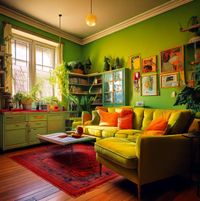Scenarios and Possible Interactive Elements
As someone who is personally heavily affected, one naturally views the world with a completely different 360-degree perspective and wishes for daily ease in recognizing dangers. These innovative technical aids could have spared me and many others from severe anaphylaxis, shortness of breath, cardiovascular issues, and in some cases, even fainting.
There is so much innovative potential to tap into ...
1. Kitchen
Food Packaging
- Creation of new interactive elements: Users could scan different types of food packaging, such as cans, plastic bottles, plastic bags and Tetra Paks (BPA inner coating). An animation could show how BPA can leach into the beverage for example orange juice. It could further detail chemical processes such as the leaching of BPA from plastic or the migration of aluminum into acidic foods. Users could be given tasks like sorting packaging according to their hazard potential and suggestions for eco-friendly packaging.
- Offering alternative solutions: The app could recommend using glass bottles or BPA-free plastic bottles and users could then view a list of brands that use safe packaging.
- A visual representation could show how BPA molecules enter the beverage and illustrate the potential health impacts, such as hormonal disruptions.
Cleaning Agents
- Creation of new interactive elements: Users could scan a bottle of all-purpose cleaner and see that it contains phthalates and ammonia. Many commercial cleaning agents contain volatile organic compounds (VOCs) that are released into the air. Cleaners with bleach or ammonia can release harmful fumes that can irritate the eyes, skin and respiratory system. A simulation could then show the negative impacts on the respiratory system. Ideally, users could compare various cleaning agents and learn which ingredients are particularly harmful. A chemical visualization could then vividly show the reactions these chemicals can trigger in the environment.
- The VR app could then suggest for example, making a homemade cleaner with vinegar and water and provide a detailed recipe. Users could then see an interactive guide on how to make the DIY cleaner at home and learn about the benefits compared to chemical cleaners.
Cookware
- Users could scan a non-stick pan and learn that it contains PFAS. Cookware made of aluminum or copper can release heavy metals into food if improperly used. The consumption of heavy metals can lead to poisoning and long-term health problems. An animation could show how these chemicals are released during cooking. Ideally, it would be possible to scan various types of cookware, including pots, pans and baking dishes. Animations could illustrate how different materials like aluminum and copper can leach into food.
- The app could then provide a virtual shopping guide, leading users to safe and sustainable cookware brands. For example, it might recommend using stainless steel or cast iron pans, which do not contain harmful chemicals. A simulation could demonstrate the differences in heat distribution and the health benefits of stainless steel and cast iron pans compared to non-stick cookware.
Living Room Section
Furniture
- Users could scan their sofa and discover that it has been treated with flame retardants that can release formaldehyde. An animation could show how these chemicals affect indoor air quality and how they enter the air through abrasion and dust. Ideally, various pieces of furniture could be scanned to provide detailed information about flame retardants and other chemicals.
- The app could recommend purchasing sustainable furniture without chemical treatments, offering tips for safe brands and materials and advice on caring for and cleaning furniture without chemicals. Users might then see a comparison table listing the chemical ingredients of various furniture brands and highlighting the health benefits of chemical-free alternatives.
Air Fresheners and Fragrances Section
- Many air fresheners and scented candles contain volatile organic compounds (VOCs) that are released into the air. VOCs can cause respiratory problems, headaches and allergic reactions. Fragrances in air fresheners and perfumes can contain phthalates, which are used to stabilize and prolong the scent. Phthalates can cause hormonal disruptions and developmental issues.
Carpets and Flooring Section
- Users could scan a carpet for example and learn that it contains PFAS. An animation could show how these chemicals enter the air and dust during normal use. Ideally, the ability to scan various floor coverings to learn about the chemicals in carpets, vinyl and laminate would be provided. Animations could then illustrate how these chemicals distribute in our indoor air. Users could conduct a virtual experiment to compare emissions from different flooring materials. The app could include a list of eco-friendly flooring materials and guides for installing these materials. An immersive 3D visualization shows the exact path of pollutant release from the flooring surface into the indoor air. Users can see the pollutant particles and track how they distribute in the room.
- Ideally a depiction of pollutant pathways: animations could show how pollutants are released through daily activities like walking, vacuuming and rearranging furniture and how they accumulate in the indoor air and house dust.
- One possibility could be an AI-based platform that analyzes user data and provides personalized recommendations for sustainable flooring and cleaning methods. The AI could also identify trends in indoor air quality and suggest proactive measures, as awareness about pollutants in flooring and their influencing factors should be given much more attention.
Detailed representations of influencing factors on pollutant emissions
1. Central Heating and Fireplace
- Increased Emissions Due to Heat: Temperature-dependent release of pollutants. At higher temperatures, the outgassing rate of VOCs and other volatile chemicals significantly increases. This particularly affects synthetic floor coverings such as vinyl and laminate. A scientifically grounded simulation could show the difference in VOC emission rates at a room temperature of 20°C compared to 25°C.
- Air Circulation, Pollutant Distribution and Convection Currents: Warm air rises while cooler air sinks, leading to enhanced distribution of pollutants. A virtual model could illustrate how air currents are intensified by heating systems and how pollutants are transported through the room. An animation could show, for example, how pollutants from a heated floor are distributed throughout the indoor air, especially near heat sources like radiators and fireplaces.
2. Sunlight and UV Radiation
- Direct sunlight and the effects of photochemical reactions: UV-induced decomposition. UV light can break down the chemical structure of pollutants and promote their release. A detailed animation could then show how UV radiation affects VOCs at the molecular level.
- A 3D animation could illustrate the influence of direct sunlight on a laminate floor treated with VOCs over the course of a day.
- Temperature increase due to sunlight and thus elevated room temperature: The warming effect of sunlight can thus intensify the release of pollutants. A simulation could show how the temperature at the floor level rises under sunlight and increases the emissions of pollutants like phthalates. The animation could compare the pollutant emissions from floor coverings in sunlit and shaded areas.
3. Moisture and Floor Cleaning
- Damp mopping, water-activated pollutants and hydrolysis reactions: Moisture can also promote the release of certain pollutants like formaldehyde. An interactive model could show how water dissolves the chemical bonds of pollutants and releases them into our indoor air. A virtual experiment could then demonstrate how damp mopping a vinyl floor increases formaldehyde emissions.
- Another representation could show the reduction of particle load, such as through dust binding. Damp mopping also binds dust particles that could otherwise transport pollutants. A simulation could illustrate how regular damp mopping reduces the amount of house dust mites and the associated pollutant load. A comparison model could, for example, show the reduction of pollutant concentration after various cleaning methods, including dry and damp mopping.
4. Addition of Further Interactive Elements
- Air Quality Monitor: An interactive air quality monitor could display the concentration of various pollutants in real-time. Users could see how indoor air quality changes over time and what factors influence it.
- Pollutant Reduction: Perhaps users could also test different cleaning and ventilation methods to reduce emissions. Methods could include vacuuming with HEPA filters, steam cleaning and using air purifiers. A virtual experiment could show how steam cleaning a carpet reduces the emissions of VOCs and phthalates.
- Extended Pollutant Categories: In addition to the previously mentioned chemicals, certain floor coverings could also contain traces of heavy metals such as lead, cadmium and mercury, originating from dyes, pigments, or adhesives. Carpets made from synthetic materials could release microplastic fibers into the indoor air, which can be inhaled. It might then be recommended to use carpets made from natural fibers like wool or cotton, which do not contain harmful chemicals. An interactive visualization could show how PFAS enters the dust and indoor air and the impact this can have on our health. Users could then see alternatives made from natural fibers and learn how they can improve indoor air quality.
Photo Prints and Digital Prints Section
- Photo prints and digital prints can affect indoor air quality, especially when stored at higher room temperatures or near heat sources such as heaters or fireplaces. Photo prints and digital prints often contain volatile organic compounds (VOCs) released from the inks and toners used. These VOCs are generated during the printing process and can off-gas from the finished prints over long periods. Many photo prints are coated with special finishes to increase their durability and colorfastness. These coatings can also contain VOCs and other chemicals that can enter the indoor air. Certain types of paper and printing materials can also contain pollutants, in addition to the printing inks used, that are released when heated. VOCs can irritate the respiratory system, causing symptoms such as coughing, sore throat and breathing difficulties. VOCs can trigger allergic reactions, including skin irritation, eye irritation and watery eyes and they can cause headaches, dizziness and nausea. At rising room temperatures, for example, from the operation of heaters or fireplaces, the outgassing rates of VOCs and other pollutants from photo prints and digital prints can be increased. This leads to higher concentrations of these pollutants in the indoor air. In poorly ventilated rooms, the pollutants can accumulate and significantly impair indoor air quality.
Lamps and Lighting Section
Fluorescent Lamps and Energy-Saving Bulbs
- Fluorescent lamps and energy-saving bulbs contain mercury, which can be released if damaged or improperly disposed of. Mercury is highly toxic and can cause severe health problems such as nerve and brain damage.
- Lamps with decorative coatings, finishes, or special surface treatments can also contain VOCs that off-gas. These compounds serve to enhance the aesthetic properties of the lamps and make them more resistant to wear and tear.
- Adhesives and sealants used in lamp assembly can contain VOCs that slowly off-gas into the surrounding air.
- Electronic ballasts and LEDs can generate electromagnetic fields (EMF), which can cause health problems for sensitive individuals.
App Features:
- An app could monitor the air quality near light sources and visualize emissions.
- AR-based recommendations could signal, for example "Use LED instead of CFL" or "Keep the light source away."
- The app could use the smartphone's camera to analyze emissions from light sources in real-time and sensors to measure VOC concentration and other pollutants near light sources.
- Users could scan the room with the app, which would show color-coded areas to visualize emissions from different light sources.
- The app could then provide specific recommendations for optimizing lighting. Users could tap on a possible color-coded area to get detailed information about the pollutants and watch videos or tutorials on eco-friendly lighting.
Electronics Section
- Users could scan a television and learn that it contains brominated flame retardants. Electronic devices such as televisions, computers and household appliances often contain brominated flame retardants (BFRs) that can enter the air and house dust. Electronic devices can contain heavy metals like lead, mercury and cadmium, especially in batteries and screens. These metals can be toxic if released and inhaled or absorbed through skin contact. An animation could show how these chemicals are released and accumulate in house dust. The app could then suggest switching to electronic devices with safer flame retardants and perhaps recommend specific brands. A detailed explanation should also be provided to highlight the differences between brominated and alternative flame retardants and their health and environmental impacts.
Bathroom Section
- Cosmetic Products: Users could scan a bottle of shampoo, for example and learn that it contains parabens, phthalates and sulfates. An animation could show the possible hormonal effects and how the chemicals enter the body through the skin. Users might then conduct a virtual experiment to test the effectiveness of natural cosmetics compared to conventional products. It could recommend using natural cosmetic products that do not contain harmful chemicals, providing a list of certified natural cosmetic brands. Users could see the health benefits of natural cosmetics compared to conventional cosmetics and learn how to further reduce hormonal load.
- Cleaning Products: Users could scan a disinfectant and see that it contains chlorine. An animation could show how the chemical irritates the respiratory system and the chemical reactions that occur when using these products. Another animation could illustrate how these reactions affect air quality and surfaces in the bathroom. Users might conduct a virtual experiment to compare the effectiveness of natural cleaning products with chemical ones. An interactive guide could show how to make and use natural disinfectants and the benefits they offer over chemical alternatives.
Children's Room Section
- Toys: Users could scan a plastic toy and discover that it contains phthalates, lead and cadmium. An animation could show how these chemicals enter children's bodies through contact and ingestion. An interactive safety test could demonstrate the safety of various toys in terms of chemical exposure. The app could recommend toxin-free toy brands and provide tips for choosing safe toys, such as toxin-free toys made from wood or other natural materials. A comparison table could highlight the differences between toxin-free and conventional toys and their health impacts on children.
- Mattresses and Bedding: Users could scan a child's bed and learn that it contains flame retardants and other chemicals. An animation could illustrate the potential health effects and how these chemicals enter the body through skin contact and inhalation. Users might conduct a virtual experiment to compare the emissions of different mattress materials. A visualization could show how chemical flame retardants enter the indoor air and what alternatives made from natural materials are available. It might be recommended to use mattresses and bedding made from natural materials without chemical treatments.
Wall Paints Section
- Users could scan the wall paint and see that it contains VOCs (volatile organic compounds). VOCs in solvent-based paints can continue to off-gas after application and drying, affecting indoor air quality. VOCs not only contribute to health problems but can also cause photochemical smog. Used as preservatives, formaldehyde can off-gas from new coatings over long periods, causing allergies or respiratory issues. Certain pigments, especially in older or imported paints, can contain heavy metals like lead or cadmium, which can be released when chipping or sanding. Wallpaper adhesive can contain VOCs and other volatile substances that are released when drying. Vinyl wallpapers can contain plasticizers that off-gas, as well as flame retardants that are also released into the air. Users could scan various wall surfaces in a virtual environment and the animations could show how pollutants off-gas from wall paints and wallpapers, distribute in the indoor air and highlight the health benefits of toxin-free wall paints. Users could scan a freshly painted wall and see through the animation how the release of VOCs and formaldehyde into the indoor air behaves, observing the release intensity over time. It might also be possible to compare different wall paints and wallpapers side-by-side to see their emission levels, with the module showing how different materials and application methods affect indoor air quality. The app could also recommend using toxin-free paints and display a list of manufacturers offering eco-friendly paints.
Curtains and Blinds Section
- Curtains and blinds are often made from synthetic textile fibers such as polyester, nylon or acrylic. These materials can be chemically treated during manufacturing to enhance their durability, color fastness and ease of care. Such treatments can release volatile organic compounds (VOCs).
- To reduce flammability, curtains and blinds are often treated with flame retardants. These chemicals can also release VOCs and other pollutants into the indoor air.
- The dyes and pigments used in the manufacture of curtains and blinds can contain VOCs and heavy metals that off-gas over time.
- To facilitate care, textile fibers are often treated with anti-wrinkle and anti-stain agents, which can also release VOCs.
Health Impacts
- Long-term exposure to pollutants such as phthalates, flame retardants and heavy metals can lead to chronic health problems, including hormonal disruptions and an increased risk of cancer.
AR and AI Integration
- Use of augmented reality (AR) and artificial intelligence (AI) to monitor air quality in rooms with curtains and blinds.
- A mobile app using AR technology to visualize pollutant emissions near curtains and blinds.
- Color-coded overlays on the screen could show the concentration of VOCs and other pollutants near these textiles, allowing users to identify pollutant sources using their smartphone camera.
- The app could then use AI to analyze pollutant sensor data and provide personalized recommendations for improving air quality, such as replacing curtains with toxin-free alternatives or washing the textiles to remove chemical residues.
- The AR app could also be connected to a smart home system to monitor air quality in real-time and take measures to improve it.
Typical VOCs from Textile Fibers
• Formaldehyde: A commonly used fixing agent that can cause severe respiratory irritation.
• Acetone: A solvent used in textile production that can cause headaches and dizziness.
• Toluene and Benzene: Solvents used in paints and coatings that can be carcinogenic.
Flame retardants are used to reduce the flammability of curtains and blinds, increasing household safety. While this offers important safety benefits, flame retardants also carry potential health risks.
Types of Flame Retardants
• Brominated Flame Retardants (BFRs): These chemicals are effective but can off-gas into indoor air and cause health problems.
• Organophosphorus Flame Retardants (OPFRs): These compounds are often used as alternatives to BFRs but can also be harmful.
Paints and dyes used in the manufacture of curtains and blinds are crucial for their aesthetic appeal but can also pose invisible dangers in the form of pollutants.
Chemical Components of Paints and Dyes
• Azo Dyes: These synthetic dyes are widely used because they produce vibrant colors. However, they can release aromatic amines, which may be carcinogenic.
• Heavy Metals: Some dyes contain heavy metals like lead and cadmium, which are harmful to health.
• Solvents: Dyes and paints can contain solvents that release VOCs and can cause health problems.
Typical VOCs from Paints and Dyes
• Toluene: A commonly used solvent that can affect the central nervous system.
• Xylene: Another solvent that can cause respiratory irritation and skin reactions.
• Ethylbenzene: A VOC that can irritate the respiratory system and affect the nervous system.
Artificial Plants and Decorations Section
- Many artificial plants and decorations are made from plastics such as PVC, polyethylene or polypropylene. These materials can release volatile organic compounds (VOCs) and other chemicals, especially when new or at higher temperatures. Some artificial plants and decorations are treated with flame retardants to reduce flammability. These chemicals can also release VOCs and other pollutants. Plasticizers are used to make plastics flexible. Phthalates can off-gas and enter the air, which can be potentially harmful to health.
App Features
- The app could recommend using natural materials such as dried flowers, wood, bamboo or recycled paper for decorative elements.
- An interactive module could showcase the best plants for air purification, along with care tips and information on the pollutants each plant most effectively filters. Users could use this information to equip their living spaces with natural air purifiers.
Doors and Seals Section
- Many lubricants contain volatile organic compounds (VOCs) that can off-gas and affect indoor air quality. These VOCs often come from the solvents in the lubricants. An interactive model could show how VOCs from lubricants in door seals enter the indoor air and their impact on air quality. Some lubricants can contain heavy metals like lead or cadmium, which can be absorbed through skin contact. A chemical analysis could show the possible concentrations of heavy metals in various lubricants and their risks. Some lubricants use siloxanes as lubricants, which can be problematic as they are not easily biodegradable and can accumulate in the environment. A simulation could show the long-term effects of siloxanes on the environment and their spread. Users could test various cleaning and maintenance methods to see how effective they are at reducing pollutant emissions. Methods could include regularly wiping down the seals or using pollutant-free lubricants. A virtual experiment could show how regular cleaning of door seals reduces VOC emissions.
Dryer Sheets Section
- Users could scan dryer sheets and discover that they contain chemical softeners. An animation could show how these chemicals transfer to the clothing and ultimately onto the skin. The app could suggest using wool dryer balls as a natural alternative and provide instructions for making DIY "fragrances" for laundry. A comparison table could highlight the differences between chemical dryer sheets and natural alternatives like wool dryer balls and their health benefits.
Construction and Renovation Materials Section
Asbestos in Older Buildings: Asbestos can be found in insulation, tile adhesives and other construction materials. It was commonly used in materials such as insulation, roofing shingles, vinyl flooring and cement due to its heat resistance and durability. However, asbestos fibers are carcinogenic and can cause severe respiratory diseases.
Solvent-based Paints and Varnishes: These often contain VOCs that are released during drying. VOCs can cause eye irritation, breathing difficulties, and long-term health problems.
Lead: Previously widely used in paints and pipes, it can still be present in older buildings. Lead dust or chips can be inhaled or ingested, leading to serious health issues.
PCBs: Formerly used in electrical devices, transformers and construction products such as sealants. Although their production is banned in many countries, they can still be present in older buildings.
Flame Retardants: Used in construction materials and furniture to reduce flammability, many of these flame retardants, such as brominated flame retardants (BFRs), are harmful to health.
Radon: A naturally occurring radioactive gas that can enter buildings from the ground. It is colorless and odorless and can only be detected through special tests.
Ah, the Eco Guardian 🌱—always looking out for our planet! I love the idea of creating various test environments in a virtual lab to explore sustainable and eco-friendly solutions. This approach can help visualize the impact of different practices and materials in a controlled setting, making it easier to understand their benefits and challenges.
Here’s how you could structure the interactive user interface
Sinks and Faucets Section
- Integrate multiple virtual sinks that users can select, each with different types of faucets (standard, high-pressure, spray nozzles).
- Allow users to adjust the water pressure and temperature to see the effects on water usage and flow.
Spray Devices Section
- Include various types of spray devices, from manual spray bottles to automatic spray systems that can clean evenly or target specific areas.
Measurement Instruments Section
- Integrate sensors and measurement instruments to display water consumption and pesticide concentration in real-time.
- Visualize this data in a clear and concise dashboard, allowing users to monitor and compare the environmental impact of different tools and settings.
This setup could help users better understand the environmental impact of their choices and encourage more sustainable practices. The Eco Guardian 🌱 would be proud of this initiative!
Virtual Lab: Removing Pesticides from Fruits and Vegetables
Interactive User Interface
Selection of Produce
- Users can choose from a variety of fruits and vegetables, such as apples, grapes, lettuce and carrots.
- Each type of produce has specific properties and cleaning needs.
Cleaning Methods
- Provide different cleaning methods: simple rinsing, soaking in vinegar solution, special cleaning agents or mechanical brushing.
- Users can adjust important parameters such as water temperature and pressure.
Vinegar Solution Adjustment
- Users can fill a sink with water and add a defined amount of vinegar.
- A slider allows the adjustment of vinegar concentration.
- Users place the produce in the sink.
- An animation shows how the vinegar solution penetrates the skin of the produce and breaks down pesticide molecules.
- A time-lapse animation shows the breakdown of pesticides over the soaking duration. Users can speed up time to observe the entire process.
- A dashboard displays current water consumption, vinegar concentration and remaining pesticide concentration.
- Users can see how efficient their method is and make adjustments.
Temperature and Pressure Adjustment
- Users can adjust the water temperature from cold to lukewarm to hot.
- An indicator shows how temperature affects pesticide removal efficiency.
- Users can also adjust the water pressure. Higher pressure may be more effective but uses more water.
- Graphs show how pressure and water consumption affect the cleaning process.
Cleaning Duration
- Users can vary the cleaning duration.
- A timeline shows how cleaning effectiveness changes over time. Longer contact time can clean more thoroughly but use more water.
Here you can live out your full potential and you're sure to come up with lots of wonderful possibilities yourself ...
Virtual Tours through Different Environments
Hospitals are critical environments where the understanding and management of chemical exposure are particularly vital.
Here's how we could structure a virtual tour of a hospital
Hospital Section
Interactive User Interface
Patient Rooms
- Users could explore typical patient rooms, highlighting the use of disinfectants, cleaning agents and air fresheners.
- Interactive elements could show how these chemicals affect indoor air quality and patient health.
- Users could learn about safer, eco-friendly cleaning alternatives that hospitals can use.
Operating Rooms
- A virtual tour could demonstrate the use of surgical instruments, sterilization chemicals and anesthetics.
- Users could see the importance of proper ventilation and air filtration in maintaining a safe environment.
- Safety protocols for handling and disposing of hazardous materials could be highlighted.
Laboratories
- Users could explore hospital laboratories where various chemicals and reagents are used.
- Interactive models could show the safe storage, handling and disposal of these chemicals.
- The tour could include information on personal protective equipment (PPE) and safety measures to protect lab staff.
Pharmacy
- A virtual tour of the hospital pharmacy could highlight the storage and handling of pharmaceuticals.
- Users could learn about the impact of certain drugs on the environment and human health.
- The tour could demonstrate how hospitals manage pharmaceutical waste responsibly.
Laundry Facilities
- Users could explore hospital laundry rooms where large quantities of detergents and disinfectants are used.
- Interactive elements could show the impact of these chemicals on workers and the environment.
- Users could learn about sustainable laundry practices and eco-friendly alternatives.
Kitchen and Cafeteria
- A virtual tour could show the use of cleaning agents, food preservatives and packaging materials in hospital kitchens.
- Users could learn about the potential health impacts of these chemicals and how kitchens manage them.
- The tour could include tips on choosing safer food products and reducing chemical exposure.
Key Features for the Hospital Tour
- Interactive Safety Drills: Users could participate in virtual safety drills to practice proper responses to chemical spills or accidents.
- Health Impact Visualizations: Animations showing the long-term health impacts of exposure to certain chemicals.
- Eco-Friendly Recommendations: Tips and recommendations for reducing chemical exposure and promoting sustainability in the hospital.
- Personalized Feedback: Based on users' interactions, the virtual tour could provide personalized feedback and suggestions for safer practices.
By incorporating these elements, the virtual tour could help users understand the importance of managing chemical exposure in hospitals and learn how to implement safer, more sustainable practices.
Factories
- Users could explore different manufacturing processes, seeing where chemicals are used and how they are managed.
- Interactive elements could show safety protocols and equipment used to protect workers from chemical exposure.
- Users could learn about the importance of proper ventilation, storage and disposal of hazardous materials.
Schools and Kindergartens
- A virtual tour could highlight areas where cleaning products and art supplies are used.
- Users could see the impact of these chemicals on indoor air quality and learn about safer alternatives.
- The tour could showcase safety measures in place to protect children from exposure.
Auto Dealerships and Workshops
- Users could explore areas where automotive fluids and chemicals are stored and used.
- Interactive models could demonstrate the importance of proper handling, storage and disposal of these chemicals.
- The tour could highlight protective gear and safety practices used by mechanics and staff.
Supermarkets
- A virtual tour could show areas where food preservatives, cleaning agents and packaging materials are present.
- Users could learn about the potential health impacts of these chemicals and how supermarkets manage them.
- The tour could include tips on choosing safer products for personal use.
Offices
- Users could explore common office supplies and equipment that may emit VOCs and other pollutants.
- The tour could highlight practices for maintaining good indoor air quality, such as proper ventilation and using low-emission materials.
- Users could see the benefits of green office practices and eco-friendly products.
Key Features for All Tours
- Interactive Safety Drills: Users could participate in virtual safety drills to practice proper responses to chemical spills or accidents.
- Health Impact Visualizations: Animations showing the long-term health impacts of exposure to certain chemicals.
- Eco-Friendly Recommendations: Tips and recommendations for reducing chemical exposure and promoting sustainability in each environment.
- Personalized Feedback: Based on users' interactions, the virtual tour could provide personalized feedback and suggestions for safer practices.
With these immersive virtual experiences, users can gain a deeper understanding of chemical exposure in various settings and learn how to protect themselves and others effectively.
Real-Time Monitoring and Analysis of Indoor Air Quality
Interactive User Interface
Continuous Monitoring
- Sensors could measure the concentration of VOCs, CO2, particulate matter and other pollutants in real-time.
- A dashboard could visualize current and historical data to identify trends.
Notifications and Recommendations
- Users could receive notifications when pollutant levels exceed certain thresholds.
- Immediate recommendations could be provided, such as opening windows or turning on air purifiers.
Comprehensive Database
Scientific Studies and Reports
- An integrated database could provide access to scientific studies and reports on the effects of chemicals.
- Users could research further information on the identified chemicals and their long-term health impacts.
User-Friendly Research Tools
- Interactive search functions could make it easier for users to find specific information.
- Summaries and overviews of studies could be presented in an easily understandable format.
Extended AR Features for Outdoor Areas
Gardens and Public Spaces
- Users could use AR technology to obtain information about pesticides and other chemicals in the environment.
- Virtual tutorials could show how to garden in an environmentally friendly way and which plants are best suited for specific soils and climates.
Environmental Monitoring
- AR could be used to monitor the quality of soil, water and air in real-time.
- Users could receive recommendations on how to reduce environmental impact and implement sustainable practices.
This contribution was written by Birgit Bortoluzzi, the creative founder of the “University of Hope” – an independent knowledge platform with a mission: to make resilience, education, and compassion visible and audible in a complex world.







